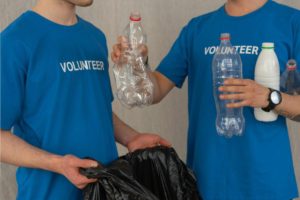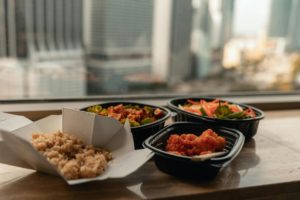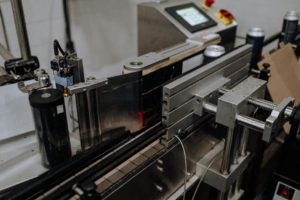At a Glance
- Plastic pact initiatives push brands toward PCR and circular systems, driving targets like 30% post-consumer recycled content and eliminating problematic plastics.
- Participation reduces risk, helping companies avoid future bans and align with retailer and policy expectations.
- Reports and data from the Pact offer actionable market insights, guiding strategic packaging decisions.
- Adapting takes time and investment, but early planning gives food businesses a competitive sustainability advantage.
Download the U.S. Plastics Pact 2023-2024 Impact Report Here
Ever feel like you’re playing an impossible game of packaging whack-a-mole? Just when you’ve solved one challenge, three more pop up. One day, your customers love plastic clamshells. Next, they want compostable banana leaf wraps (we hope that metaphorical joke is false). How do you adapt to these changes while still being profitable and efficient in operations? Don’t worry — you’re not alone in this packaging predicament. While many are trying to define “sustainable,” smart food businesses have a guide: the U.S. Plastics Pact.
This week, we sat down with Conor Carlin, Founder & President of Clefs Advisory LLC. Working where packaging meets sustainability, Conor was the 2024 President of the Society of Plastics Engineers and previously served as former General Manager for ILLIG in North America. He brings valuable expertise in materials, packaging technologies, policy development, commercial strategy, and market intelligence to the industry.
The U.S. Plastics Pact offers a roadmap through this complex terrain — but only for those who understand how to leverage its insights. Today, we’ll explore that.
What is The U.S. Plastics Pact?
 The U.S. Plastics Pact started in August 2020. It unites various groups across the plastics packaging value chain. Unlike government rules, the U.S. Plastics Pact is a voluntary group comprising businesses, recyclers, and other organizations. Together, they aim for common sustainability goals.
The U.S. Plastics Pact started in August 2020. It unites various groups across the plastics packaging value chain. Unlike government rules, the U.S. Plastics Pact is a voluntary group comprising businesses, recyclers, and other organizations. Together, they aim for common sustainability goals.
So why did the U.S. Plastics Pact come about? Remember when everyone binge-watched David Attenborough’s Blue Planet and suddenly plastic straws became public enemy #1? We all felt for that poor sea turtle. You know the one. In addition, the Ellen MacArthur Foundation raised important issues about circular economies, states enacted their own packaging laws, and shoppers started to question excessive packaging. This all created the perfect storm (in this case, “storm” refers to a good thing).
The team at the U.S. Plastics Pact learned an important lesson: improving the environmental impact of packaging goes beyond just changing materials. It’s about changing the entire system, from resin selection to consumers’ recycling bins. We need to rethink what we make and how consumers use it. We should also improve recycling setups, rethink brand marketing, and push away the stubborn “we’ve always done it this way” mindset.
How the U.S. Plastics Pact Operates: Targets and Agreements
Let’s get right down to how it all works. The U.S. Plastics Pact operates through voluntary agreements and specific targets. Member organizations work together to decide what plastics are “problematic or unnecessary.” They also set goals for better, more environmentally friendly packaging systems.
Key Focus Areas:
- Problematic materials identified: The U.S. Plastics Pact published a list of 11 items (see below) that are seen as problematic or unnecessary in packaging.
- Post-consumer recycled content (PCR): Driving increased use of recycled materials in new packaging.
- Compostability: Promoting both compostable packaging materials and the infrastructure needed to process them properly.
- Bio-based content: Promoting packaging materials made from renewable resources.
Food packaging companies must know which materials are on the “problematic” list. This knowledge is key for developing future products and managing risks. These “problematic materials” include: 
- Nondetectable pigments such as carbon black
- PETG: polyethylene terephthalate glycol in rigid packaging
- Intentionally added per- and polyfluoroalkyl substances (PFAS)
For the complete list, see page 10 of the current 2023-2024 Impact Report.
The Strategic Value for Food Businesses
Why should food business professionals pay attention to a voluntary initiative like the U.S. Plastics Pact? The knowledge may not be the most exciting topic to discuss at a dinner party, but it serves multiple strategic functions:
Risk Management
If your company manufactures or uses items on the U.S. Plastics Pact’s “problematic or unnecessary” list, this represents a significant red flag. Major brands and retailers increasingly use these designations to inform purchasing decisions. For example, if you produce or utilize plastic cutlery for takeaway food service, you’re likely already in the crosshairs of changing market preferences.
Policy Influence
 The U.S. Plastics Pact functions as a corporate-backed counterpoint to more aggressive anti-plastic advocacy. For policymakers and regulators at both state and federal levels, it demonstrates the industry’s willingness to self-regulate. The underlying message is: “If we can show progress through voluntary measures, perhaps outright bans aren’t necessary.”
The U.S. Plastics Pact functions as a corporate-backed counterpoint to more aggressive anti-plastic advocacy. For policymakers and regulators at both state and federal levels, it demonstrates the industry’s willingness to self-regulate. The underlying message is: “If we can show progress through voluntary measures, perhaps outright bans aren’t necessary.”
Market Intelligence
Think of the U.S. Plastics Pact’s reports as your packaging trend forecast. Released about every two years, these free reports are like a sneak peek into the industry’s future. They show you which packaging types are gaining traction and which ones might soon be as outdated as foam clamshells at a green restaurant. Smart food companies use these insights to stay ahead of the curve instead of playing catch-up later.
Understanding the Targets
The U.S. Plastics Pact has established four primary targets that food businesses should monitor:
- Eliminating problematic or unnecessary packaging: Currently, only 22% of member companies report selling zero items on the problematic list — a figure that reveals the significant challenges in transitioning away from certain materials. Nobody ever said change was easy.
- Increasing PCR content: Targets call for reaching 30% post-consumer recycled content by specific dates.
- Designing for recyclability: Ensuring packaging can be effectively recycled in practice and at scale.
- Improving recovery and recycling rates: Working towards significantly higher recycling rates for plastic packaging.
Real-World Applications and Challenges
Implementing the U.S. Plastics Pact’s recommendations presents numerous practical challenges for food businesses:
Retooling Costs
Want to switch to packaging with more PCR or with bio-based content? Prepare for a price shock. Changing your packaging isn’t just about ordering different containers — it often means investing in completely new manufacturing equipment.

And that’s just the beginning. Before you can roll out that eco-friendly packaging, you need to put it through rigorous testing. Will it keep your food fresh? Can it survive shipping and handling? Will it maintain shelf appeal? These questions can go on for pages and pages. Getting these answers isn’t quick — testing and certification can take anywhere from eight months to two years or more. This isn’t a simple menu update — it’s a major business transformation that takes time and money.
Substitution Problems
Consider the case of PLA (Polylactic Acid), a biodegradable plastic derived from renewable resources like corn starch or sugarcane. While PLA is praised for its compostability and reduced reliance on fossil fuels, it presents challenges in recycling streams. Unlike traditional plastics, PLA requires industrial composting facilities to break down properly and can contaminate conventional plastic recycling processes if not separated correctly.
For food businesses using PLA packaging, this shift represents both a regulatory challenge and potential consumer confusion.
Using This Info as a Competitive Edge
Forward-thinking food businesses can use the U.S. Plastics Pact as more than a compliance guideline — it can become a strategic advantage.
Three Steps to Take Now:
- Audit your packaging portfolio against The U.S. Plastics Pact’s problematic materials list to identify areas of vulnerability.
- Develop transition timelines for any high-risk packaging formats, recognizing that material substitutions require substantial lead time.
- Communicate proactively with customers and stakeholders about your sustainability journey, even when progress comes incrementally.
Turning Knowledge into Pact-ion
 The U.S. Plastics Pact represents both a challenge and an opportunity for food business professionals. Those who dismiss it as just “voluntary” miss its significance as a market signal and potential regulatory precursor.
The U.S. Plastics Pact represents both a challenge and an opportunity for food business professionals. Those who dismiss it as just “voluntary” miss its significance as a market signal and potential regulatory precursor.
Learn the U.S. Plastics Pact’s goals, watch its progress reports, and shape your packaging strategy to fit its direction. This will help your business deal with changes confidently, not in a crisis. This knowledge gives a competitive edge in a market where consumers want sustainable solutions. It sets industry leaders apart from those struggling to adapt.
The report, available for free download (click here), offers essential insights for any food business committed to thriving in tomorrow’s marketplace. Will your business be prepared?
Want to know more about sustainability in food packaging? Visit our Learning Center today. Have any questions? Feel free to reach out anytime. We’re here to help.
Would you like to know more about Conor Carlin and his work at Clefs Advisory LLC? Connect with him on LinkedIn today.

